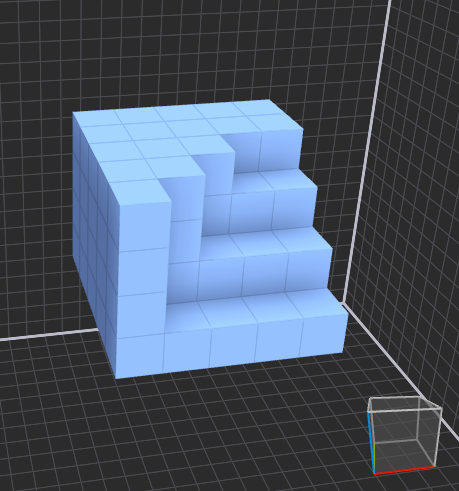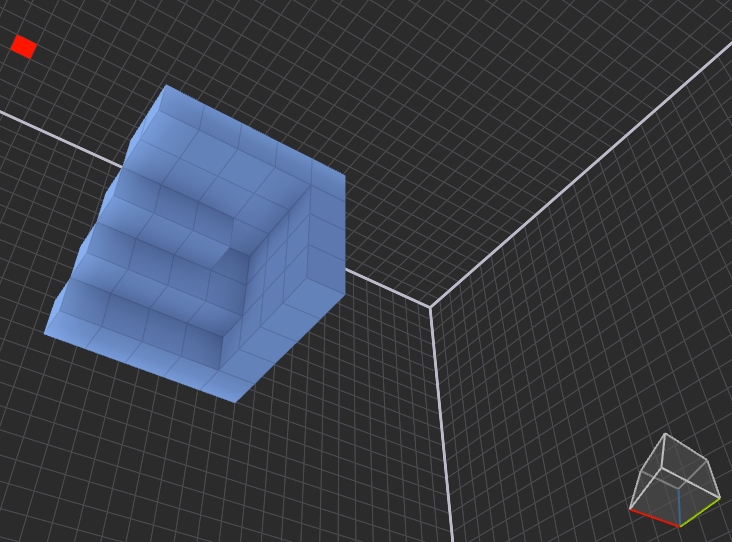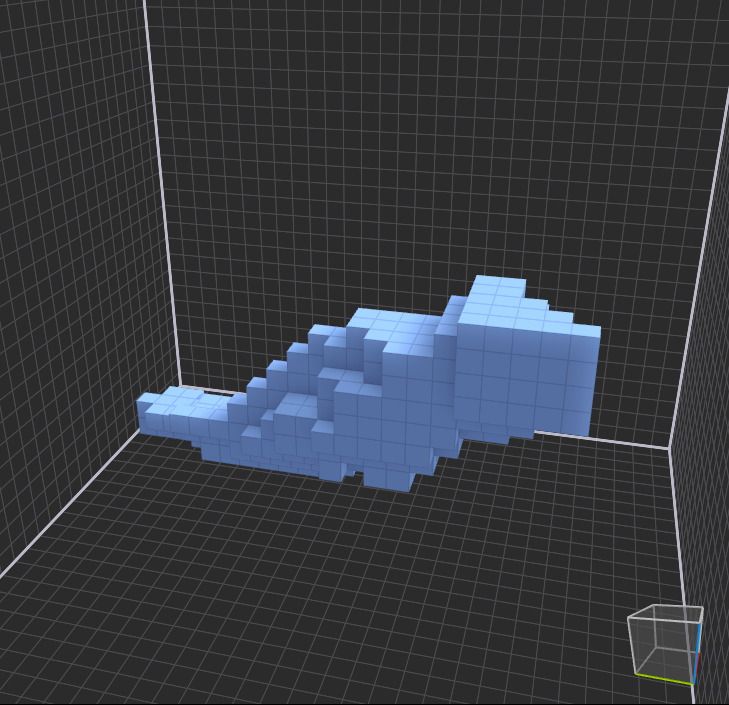And why I don't like them..
Let's begin with the puzzle that inspired this article. "How many small cubes are needed to finish the big cube?" think of your answer and the we can analyze it together.

So at this point, you should have thought about your answer and have some idea in your head. I'll tell you the story of how this played out in my head when I originally went along with this and how I realized why I have hated these puzzles for so long.
The answer
There is usually a trick to these that is designed to throw you off in some way. The common set of answers for this problem are 20, 45 and 82. Let's look at the reasoning behind those answers.
20 is the amount of blocks missing up to the highest level of the stack. People who give this answer may have overlooked the fact that 4x5x5 is not strictly a cube.
45 is the previous answer adjusted to fill the 5-cube, where you would add a layer to the top or bottom of the pictured stack.
82 or "something between 45 to 82" is the answer that asks the question whether there are blocks behind the visible ones. This option is already on the nerdy side and is not commonly considered or discussed much further.
Additionally, 0 can be considered an answer if you assume the 2-cube or 3-cube are already complete and can be considered a finished cube.
Constraints
In order for the presumed missing fifth layer to be a misleading fact the question can not state that you are supposed to fill a 5-cube. However the puzzle maker did not realize that in deconstructing the premise, additional avenues of thought were made possible.
So my initial full answer was N*N*N - (5*5*5 - 45) -x where N is the size of n-cube you wish to fill above the fifth order and x is the amount of cubes needed to fill in behind the visible structure. Though this does not account for the fact that the 2-cube and 3-cube are possibly already complete. Also assuming there is gravity and the cubes are stacked, you only need 5 more to complete the 4-cube.
Is the problem an abstract one or a realistic scenario? Hard to say, as logical problems are not usually interpreted as conforming to the real world, that is where gravity applies and all that. So I would say there is no strong reason to assume gravity here.
What's behind the stack?
So assuming that there may be cubes missing is essentially just as valid as assuming that there are additional blocks behind what we see. It turns out there can be arbitrarily many blocks behind what we see.

So if we accept there can be additional blocks, we run into the issue that there would be an unknown amount of them. Where if this information exists, we can not solve the problem with the data we have. Though the given formula would still give an answer if we knew what values to input.
No block universe in the shadows
So let's forget about adding blocks behind the structure. So here we are back to 82 being the amount needed to fill the 5-cube, which is the smallest cube we can build around what we see. So we should assume there are no extra blocks beyond what we see. Image from behind below.

Now we seem to be at a more sensible solution, but we have likely made the puzzle much harder than intended, as most people seem to agree that the correct answer is 45.
Also, there is still the assumption that the 5-cube is what we are filling, which is likely because we don't want to leave extra blocks or imagine creating more than a minimal amount. Comforting and understandable constraints for humans, but are they the only options?
As a side note, a short explanation and the formula I gave as my initial answer can provide numerical answers in all the selected scenarios. So is it right or wrong now?
Can we move the blocks?
So we got all this way and did complex things with our minds, but there is still an assumption we did not cover. Are we allowed to move around blocks? So if we say yes, that there are no unseen blocks, and that we can not leave unused blocks so that we can placate our OCD. Now the correct answer becomes 21, in order to form a 4-cube that has 64 components in total. Why should we be allowed to move cubes? I don't know, maybe because there are normally no immovable objects? Or is it more important that we assume someone intended for the stack to be static? If we start assuming that there is a someone who has free will and they decided some property we have to guess. How is this now any different from "what number am I thinking of?" used as a fake logical puzzle? Regardless, people do almost uniformly make these decisions that seem more social or cultural than logical or scientific. I would argue that this IQ-test like setting and somewhat abstract graphic assumes a more logical setting rather than an arbitrary question with a predetermined secret answer. Though in reality the opposite seems to be true, as the accepted answer is 45.

Comparisons
So if we take the default "45 to complete a physical stack into a 5-cube" and compare it to "21 to build a 4-cube from the amount of blocks we see". Which is the better answer? Why is the other one wrong?
Neither is wrong if you ask me. Both are equally arbitrarily chosen and have nearly the same kind of assumptions. Both go beyond what is defined by the question and both give very logical answers that are objectively and logically sound. That, I think makes this as a problem objectively better than one that has only a single answer, but very boring as a puzzle because of how many options there are for being right. Which would you say teaches people more about life and realistic problem solving? Hopefully you agree that it is the dirty complex one that teaches there is more than one way to think. Our value system would agree with this, unless you are form a totalitarian society (Hello! Are you using Tor to find forbidden information?).
Discussion
I think if we would ask people how they came up with their original answers, we would not get very solid reasoning behind the assumptions. We would probably get a few different ways or reasoning that provide the same answer and especially importantly - no reasoning at all. Intuition is a good way to arrive at solutions, but you run the risk of making decisions that are not conscious or include hidden assumptions.
I think that the main reason for 45 being the right answer is that so many people arrive at that solution. So is problem solving and science to be done as a democracy? I think most scientists would say that science is a different kind of democracy, where you must also base solutions on logic and reasoning beyond opinions. Science is not done my group vote, but by consensus based on objective logic and repeatable experiments. The solutions also need to be testable, falsifiable, and not arbitrary.
I think people are inadvertently being taught to act as a hive-mind in service of authority or to solve problems using democratic voting or consensus, rather than evaluating facts or basing their solutions on reality or even creativity. Being creative does not automatically mean you are breaking the rules or doing something wrong, though this is often a connotation that is implied. Especially in teaching mathematics or sciences. True creativity is imagining more than what you see and finding solutions that are more expressive and more useful than existing ones. Even famous physicists talk about the value of intuition and creativity, where else do you think new theories come from..
Scientific method, sort of..
So let's be a little creative and work on falsifying and developing my exhaustively complex answer from above. Can you guess what I will propose? So the answer that gives a solution based on some of our assumptions is N*N*N - (5*5*5 - 45)- x, where N is the assumed size of the final cube from 6 to infinity (or zero for 5 and under), and x is the amount of blocks to add or remove so that we reach the n-cube basis we want.
So we considered whether gravity is an issue or property that we can assume in this scenario. Let's see if we can find a way to falsify my hypothesis and develop a competing theory by extending this thinking.
So if people say of course there are blocks behind and gravity exists because the stack would not hold it's form otherwise (technically not true). Anyway, I would propose that this hybrid real/abstract problem could also have more than 3 dimensions. Though we will only expand to more physical dimensions similar to the familiar x,y,z. In that case we would need to add more multipliers (N and 5) to the relevant spots and make the constant 45 be a variable dependent on number of dimensions. So now we can have more than 3 dimensions into which we can expand our cube or hypercube if you like. (If you want to figure out the resulting formula, tweet @rndpeter or let me know somehow what you come up with. I'm too far in this right now already.) And we are also assuming that any higher dimension blocks are by default missing.
This example describes the scientific method well in some respect, because the 3 dimensional version of our new formula still gives the same base function and the same answer, but now it also works in a larger more complex world. Developing to become more descriptive while retaining it's relation to perceived reality.
Conclusion
So actually my answer was also 45 for the same assumptions you gave, except I took into account a lot of the undefined variables that the problem can have. And granted, I still fail to see why 45 is the right answer. But did you perhaps fail to see that we are talking about the same thing? People often perceive differences where there actually are none. This is not even related to real vs abstract, it's just a way of thinking creatively and somewhat exhaustively. So in some sense we may agree on the result, but I wonder if you were aware of the assumptions you made along the way to your answer? Also, do you still think the puzzle is a good one, or is it a good problem?
The default solutions to puzzles like this one, are in my mind great for forcing people to think inside the box and letting go of exploring new possibilities. Which points to why differing creative answers should be explored and analyzed, instead of being discounted as not right or too complex. While in a perfect world all questions would be better defined, or at least people would be applauded for finding new ways to think of them, please remember to at least be kind to people who give weird answers. Possibly even explore them together, you may find that you were not disagreeing after all and that the world is a bit weirder than you originally thought. Then again, some people are just crazy, but don't assume, find it out or hold your judgement.
Sources
- Introspection
